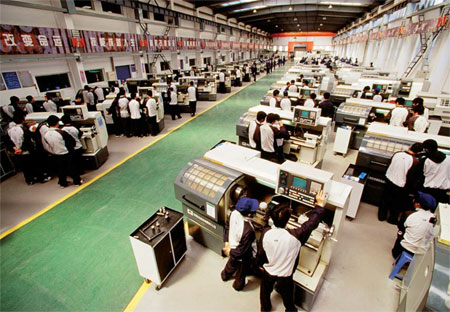Fit for the job
Updated: 2014-09-05 10:27
By Hu Haiyan and Andrew Moody(China Daily Europe)
|
|||||||||||


Big initiative on vocational training is to upgrade the economy
Shenyang in China's industrial northeast, dominated by heavy industry and leviathan state-owned enterprises, may seem an unlikely model for the modernization of the country's economy.
The capital of Liaoning province, whose main industries include machine tools, heavy equipment and the homegrown Shenyang Aircraft Corporation and Brilliance Auto - a leading Chinese carmaker - is seen as a leader in vocational training.
It has had a long tradition in turning out the skills that industry needs and in 2010 was designated as one of 10 vocational training pilot areas.
The Chinese government made clear in May that it regarded such training as central to the country shedding its cheap "Made in China" price tag and switching to more higher-cost manufacturing and services.
It announced that it wanted to increase the number of vocational places from the current 29.34 million students studying at 13,600 vocational schools and colleges across China by almost a third to 38.3 million by 2020.
The government was making it clear that while university graduates with degrees from Chinese and Western universities were a part of the upscaling journey, the greater need will be for skilled people in the wider workforce.
In Shenyang there has already been significant progress in redesigning vocational training.
Over the past decade about 30 vocational training schools have been consolidated into nine, each providing workers for designated pillar industries such as equipment manufacturing, information technology and services.
Part of the success of the new system is that of the 10,000 students who graduate each year between 95 and 98 percent get jobs.
Liu Zhimin, 48, the vice-director of the bureau of education in Shenyang, says the reforms that may be a blueprint for the rest of the country are already showing evidence of working.
"The quality of the labor force decides the quality of the industrial transformation," he says.
"We have made great efforts to boost collaboration between schools and companies to ensure that the students trained in the vocational education schools are in line with market needs."
Liu, an urbane figure who was speaking in the bureau's expansive building in the center of the city, says the government's new policy of expanding vocational education across the country has particular resonance in Shenyang.
"As a city well known for vocational training, there is a lot of interest in the new policy. We are busy studying the central government's proposals closely and are looking for ways to improve vocational training here."
Premier Li Keqiang made clear the extent to which vocational training had moved up the economic agenda in June at a specially convened conference in Beijing devoted to the topic.
He said having a more skilled workforce could go a long way to building China's future economic success.
"Imagine the scale and level of Chinese products and services if most of our 900 million labor force can be trained to master medium and high-level skills," he said.
China is not alone in seeing a renewed role for vocational training. In the UK, former prime minister Tony Blair's target more than a decade ago of sending 50 percent of the young population to university no longer seems a desirable goal.
Many graduates, heavily in debt with student loans, often fail to get jobs commensurate with the money and time they have spent on their courses.
A recent report by McKinsey & Co, "Education to Employment: Getting Europe's Youth into Work", found that more than half of young people taking an academic course in Europe would have rather opted for a vocational one in most of the countries surveyed, such was their disillusionment with their prospects.
One of the problems highlighted by the report was that vocational training was badly organized and confused, with Britain alone having 20,000 vocational qualifications offered by 150 different institutions.
If China's investment in vocational education proves to be a success, it may also provide a template for some European countries and the United States, where vocational training also lacks a coherent structure.
One of the barriers to encouraging people to do vocational training is the perception they will earn less money than those who go to university.
Zhao Yongsheng, 31, deputy secretary of the Communist Youth League Committee of Shenyang, says in China this is not always the case.
He says those with vocational qualifications often command a starting salary of 3,000 yuan ($490, 370 euros) a month, almost 50 percent above the 2,100 yuan of the average graduate recruit.
"Many college graduates cannot find desirable jobs because there is a gap between the real needs of the workplace and what a graduate has to offer."
His view is supported by Zhang Chunyu, principal of one of Shenyang's largest vocational training centers, Shenyang Equipment Manufacturing Engineering School.
The 49-year-old, who has been in his present post for five years and has been a key player in some of the recent reforms, says the gap can be maintained even over the course of a career, particularly when someone combines academic and vocational training.
"Students with both vocational certificates and academic degrees will be very competitive in the jobs market.
"These can expect better pay over the lifetime of their careers than those who have simply gone to university."
One country that has placed particular emphasis on vocational training is Germany, which many see as having played a role in its economic success, particularly in building a strong engineering sector.
Those behind the vocational training reforms in Shenyang are very conscious of what lessons they can learn from Germany, the exception in Europe in having a highly efficient vocational training system.
German car giant BMW has two major manufacturing factories in the city, one in Dadong district and the other is in Shenyang Economic Development Zone, also known as Tiexi district.
Living examples of successful vocational training products in terms of German engineers and other skilled professionals can be seen everywhere in the city's hotels, many of them brought in by Lufthansa's three direct flights to Shenyang's airport every week.
Helmut Schonleber, sector director of vocational education and training projects Deutsche Gesellschaft fuer Internationale Zusammenarbeit (GIZ) GmbH, the global advisory services consultancy, says vocational training could prove as effective in China as it has in Germany.
"Why has a small country without natural resources such as Germany become so successful as a global supplier of top quality products?" he says. "The secret is the excellence of Germany's workforce, guaranteed by the excellence of its vocational education system."
GIZ, which operates in 130 countries, has worked in Northeast China for 28 years and has specialized in vocational training support.
Schonleber says it is clear why vocational training is vital for China to upgrade its industrial base.
"High-quality manufacturing can be achieved in two ways: the first is a very high level of automation, using high-precision and highly reliable machinery and equipment but very few people; and the second is using highly qualified people to manufacture things that are not produced by robots.
"We are already seeing a lot of the first in China, with robots, many of them made in Germany, producing the latest iPhones and BMWs, but the second is much more typical for Germany than for China, and it is in this where vocational training can play a role here."
BMW itself sees training the local workforce as vital to its plans in the city. It set up the BMW Brilliance Automotive Research and Development Center in September last year.
It hopes that in future it will be able not just to make cars in Shenyang but to create and design new models for the China market as well.
The BBA R&D Center started its own New Vocational Education training program in 2012, and the first batch of 45 apprentices completed their education this summer.
"At the beginning, these apprentices will take on the role of technicians and they then have the opportunity to be promoted to section leaders or technical specialists if they are qualified. Managerial positions will be the next role for them," said a spokesperson for BMW.
The company has criticized the existing Chinese vocational training system, particularly the failure to connect students and companies early enough in training programs.
Under the system operated at BBA in Shenyang, students have a clear idea from the start about where they will eventually fit in with their future employer.
"Students (in China) don't know what they will do after graduation and sometimes what they learn will have little connection with their future," the spokesperson said.
"(Our system) is based on the German dual vocational system Students know which company they will join in and what position they will take at very beginning of the program."
One who knows the German training methods well is Jens Li, 35, vice-president of Wurth Industrial Park in Shenyang, which is located in the European Union Development Zone and is home to a number of German companies.
"German vocational education has delivered a more productive workforce. German workers are more proficient, one worker can supervise five machines, yet Chinese workers can just take care of three."
Yu Zuguang, vice-chairman of the Chinese Society of Vocational and Technical Education, a research institute for vocational education, says the German system is ideal for China.
"Their vocation education is well designed and the training is closely linked to employers' needs. We need to learn from this. Partnerships between vocational schools and employers should be encouraged and supported by government polices and financial endorsements."
However, the numbers graduating from China's vocational schools would be beyond the capacity of even the German system.
During the 11th Five-Year Plan (2006-10), about 80 million students, as many as the entire population of Germany, graduated from Chinese vocational schools, about 60 percent of all new employees and the major source of those in the mid to high-level skilled worker category, according to China's Ministry of Education.
Graduates from vocational schools now make up more than 70 percent of those going into high-end manufacturing, high-speed rail, urban transport systems, civil aviation, logistics, e-commerce and tourism and information services.
Vocational training has also been a fillip to social mobility, with 5 million students moving out of rural poverty to better paid jobs in the city.
Across the country, those who graduated from vocational colleges in 2010 on average doubled their salary after working for just three years. About 58 percent were also promoted.
Lu Xin, China's vice-minister of education, said at a news conference in Beijing in June that vocational training was giving many access to jobs and salaries they would have never have had in the past.
"Graduates coming out of higher vocational training have huge potential to improve their lives. They will also be able to play a significant role in facilitating China's economic transformation and industrial upgrading."
In Shenyang, such is the enthusiasm for vocational training that the Communist Youth League Committee has been running a national competition for 10 years with students competing for the Zhengxing Cup.
"It is very popular. Most of the participants are in their 20s and the winners have had their lives changed, often going on to well-paid jobs," says Zhao of the Communist Youth League Committee.
"It is not only an honor, but also a kind of recognition and life-changing opportunity."
Eric Qin, a manager at Arnold Fasteners (Shenyang), in Wurth Industrial Park, says the key to making vocational training work is close links between companies and colleges.
Arnold has developed a close links to Shenyang Equipment Manufacturing Engineering School and has been involved in training students on the school site.
"Such cooperation benefits both sides. It creates employment opportunities and we can find workers," he says.
Li Yinghua, director of the management committee of Shenyang-European Union Economic Development Zone, the only designated EU development zone in China, says vocational training is now core to the success of the local economy.
About 816,000 motor vehicles, including those of BMW, were produced in the zone last year, generating revenue of 105.6 billion yuan.
"The fast development is hugely reliant on the development of vocational education in the zone. Without it there would be no large-scale car industry here."
Li, speaking in his office located in Dadong district of the city, says the zone is entirely reliant on vocational schools within a distance of 5 kilometers, and the two within the zone itself.
"BMW may recruit its senior managers from across the world but all the other workers, be they high-level engineers or technicians, can be found locally."
As in Europe, there is still a perception that vocational training is a second-best option, with many parents preferring their children to pursue academic studies.
In Beijing, Yu at the Chinese Society of Vocational and Technical Training who is also a former vice-director of the Central Institute for Vocational and Technical Education affiliated to the Ministry of Education, believes the biggest achievement of the government's latest initiative could be in putting vocational training center stage.
"This mindset has existed for a long time. That so many high-ranking officials gathered in Beijing in June to endorse the new policy creates an unprecedented opportunity to change this perception once and for all."
Contact the writers through
huhaiyan@chinadaily.com.cn
|
Students of Shenyang Equipment Manufacturing Engineering School hone their skills under the guidance of a teacher in their classroom. Provided to China Daily |
|
From left: Li Yinghua, director of the management committee of Shenyang-European Union Economic Development Zone; Zhao Yongsheng, deputy secretary of the Communist Youth League Committee of Shenyang; Liu Zhimin, vice-director of the bureau of education in Shenyang; and Helmut Schonleber, sector director of vocational education and training projects Deutsche Gesellschaft fuer Internationale Zusammenarbeit (GIZ) GmbH. Photos by Liu Ce / China Daily |
|
Students at Shenyang Equipment Manufacturing Engineering School. Provided to China Daily |
(China Daily European Weekly 09/05/2014 page6)
Today's Top News
NATO to offer tailored support to Ukraine
Babies bob about in water at US's first baby spa
News website staff face extortion probe
China's meeting on 13th five-yr plan
Number of visitors to China drops
Export of mooncakes on the rise
Putin outlines ceasefire plan for Ukraine crisis
China paves way for sports investors
Hot Topics
Lunar probe , China growth forecasts, Emission rules get tougher, China seen through 'colored lens', International board,
Editor's Picks

|

|

|

|

|

|








